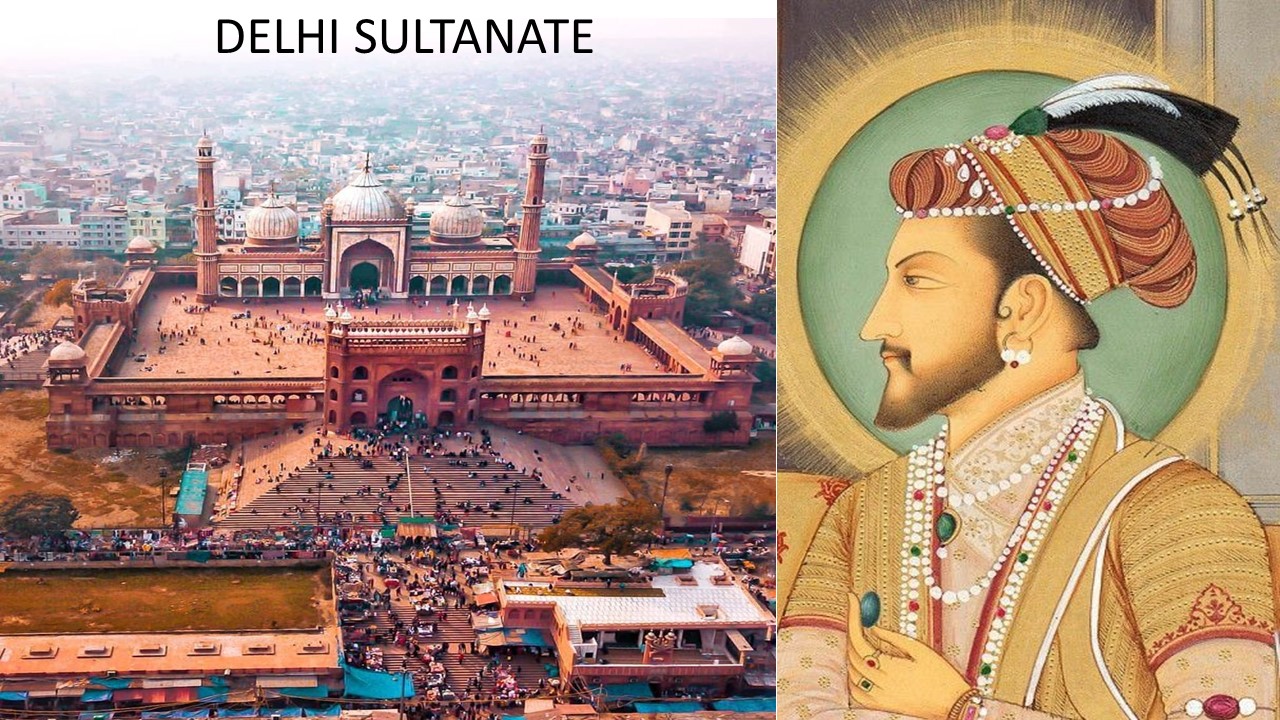
Delhi Sultanate Explained: Dynasties, Rulers & Legacy
Explore the Indo-Islamic architecture of the Delhi Sultanate, including its styles, key features, and iconic structures like Qutub Minar, Alai Darwaza, and Tughlaqabad Fort. Perfect for history and exam prep.
The Delhi Sultanate (1206–1526) was a Muslim kingdom that ruled large parts of northern India before the Mughal Empire, established by Qutb-ud-din Aibak.
The Delhi Sultanate was a series of five short-lived Muslim dynasties that ruled northern India from 1206 to 1526. It started with the Mamluk (Slave) Dynasty under Qutb-ud-din Aibak, followed by the Khilji, Tughlaq, Sayyid, and Lodi dynasties. These rulers introduced centralized administration, Persian culture, and significant architectural developments like Qutub Minar. The Sultanate fell after Babur defeated Ibrahim Lodi in the Battle of Panipat (1526), marking the beginning of the Mughal Empire.
Key Points
- Founder: Qutb-ud-din Aibak (1206)
- Famous Rulers: Alauddin Khilji, Muhammad bin Tughlaq, Firoz Shah Tughlaq
- End: 1526, defeated by Babur
- Dynasties: Mamluk → Khilji → Tughlaq → Sayyid → Lodi
- Significance: Introduced Persian culture, Islamic architecture, and military reforms
Delhi Sultanate (1206–1526)
The Delhi Sultanate was a Muslim kingdom based mostly in Delhi that ruled over large parts of the Indian subcontinent for over three centuries. It was established after the defeat of the Rajput kingdoms by Muhammad Ghori, and later governed by his general Qutb-ud-din Aibak, who became the first Sultan of Delhi.
Five Dynasties of the Delhi Sultanate:
1. Mamluk (Slave) Dynasty (1206–1290)
- Founder: Qutb-ud-din Aibak (slave of Muhammad Ghori)
- Capital: Delhi
- Important Rulers:
- Qutb-ud-din Aibak: Built Qutub Minar, started construction of Quwwat-ul-Islam mosque
- Iltutmish: Consolidated empire, introduced Iqtadari system, got recognition from the Caliph
- Razia Sultana: First and only female ruler of Delhi
- End of dynasty: Kaiqubad’s weak rule led to its fall
2. Khilji Dynasty (1290–1320)
- Founder: Jalal-ud-din Khilji
- Important Ruler:
- Alauddin Khilji: Known for market reforms, military reforms, controlled Mongol invasions, and expanded the empire to south India
- Maintained cheap food grains, and fixed prices
- Famous General: Malik Kafur – led Deccan expeditions
3. Tughlaq Dynasty (1320–1414)
Founder: Ghiyas-ud-din Tughlaq
Important Rulers:
Muhammad bin Tughlaq: Known for ambitious projects and failure of policies like:
Transfer of capital from Delhi to Daulatabad
Introduction of token currency (copper coins)
Firoz Shah Tughlaq: Focused on public works (canals, hospitals), and encouraged Islamic learning
Decline due to rebellions and weak successors
4. Sayyid Dynasty (1414–1451)
- Founder: Khizr Khan (appointed governor by Timur)
- Ruled small territory, considered puppet rulers under Timur’s influence
- Decline due to weak administration and local revolts
5. Lodi Dynasty (1451–1526)
- Founder: Bahlol Lodi (first Afghan dynasty to rule India)
- Important Ruler:
- Sikandar Lodi: Encouraged agriculture and trade, shifted capital to Agra
- Ibrahim Lodi: Faced internal dissent and was defeated by Babur in the First Battle of Panipat (1526)
- This battle marked the end of the Delhi Sultanate and the start of the Mughal Empire
Cultural & Administrative Contributions:
- Persian language became official language
- Introduction of Iqtadari system (land revenue-based administration)
- Construction of monuments: Qutub Minar, Alai Darwaza, Hauz Khas
- Growth of Indo-Islamic architecture, art, and culture
- Strengthening of centralized governance
Important Battles:
Battle of Panipat (1526): Babur vs Ibrahim Lodi – led to the fall of the Sultanate
Mongol invasions were frequently repelled by Alauddin Khilji
Dynasty | Period | Key Rulers |
|---|---|---|
| Mamluk | 1206–1290 | Qutb-ud-din Aibak, Iltutmish, Razia Sultana |
| Khilji | 1290–1320 | Alauddin Khilji |
| Tughlaq | 1320–1414 | Muhammad bin Tughlaq, Firoz Shah |
| Sayyid | 1414–1451 | Khizr Khan |
| Lodi | 1451–1526 | Sikandar Lodi, Ibrahim Lodi |
Explanation of Delhi Sultanate Architecture: Styles, Features & Famous Monuments—perfect for exam prep or historical understanding.
Delhi Sultanate Architecture: Styles, Features & Famous Monuments
Overview
The architecture of the Delhi Sultanate (1206–1526 CE) introduced a new style in India known as Indo-Islamic architecture, which blended Persian, Turkish, and Indian elements. It was a significant phase in Indian architectural history, laying the groundwork for later Mughal architecture.
Key Architectural Styles
- Indo-Islamic Style:
- Introduced true arches and domes.
- Absence of idol sculptures, replaced by geometric, floral patterns, and calligraphy.
- Use of red sandstone, white marble, and rubble masonry.
- Arcuate Technique:
- Arches and domes constructed with voussoirs (wedge-shaped stones).
- This was a shift from the traditional trabeate (beam and post) system used in Hindu architecture.
Major Features
- Pointed Arches & Domes
- High Minarets
- Mihrabs and Mehrabs (Prayer niches)
- Use of Calligraphy: Arabic and Persian inscriptions from Quran.
- Minbar: Pulpits in mosques.
- Charbagh gardens (beginning of Islamic garden layout in India).
- Jali work: Decorative lattice screens.
Famous Monuments by Dynasties
Mamluk (Slave) Dynasty
- Qutub Minar (Delhi): Built by Qutb-ud-din Aibak and completed by Iltutmish. Tallest brick minaret in the world.
- Quwwat-ul-Islam Mosque: First mosque built in India by Delhi Sultans.
Khilji Dynasty
- Alai Darwaza (Delhi): Known for intricate Islamic calligraphy and architectural finesse.
- Expansion of Qutub complex by Alauddin Khilji.
Tughlaq Dynasty
- Tughlaqabad Fort: Built by Ghiyas-ud-din Tughlaq; massive and austere fortification.
- Feroz Shah Kotla: Contains Ashokan pillar brought from Topra.
- Hauz Khas Complex: Includes a madrasa, tomb, and mosque.
Sayyid & Lodi Dynasties
- Emphasis on tomb architecture.
- Lodhi Gardens (Delhi): Tombs of Sikander Lodi, Muhammad Shah.
- Use of octagonal tombs and domes.
Legacy
The Delhi Sultanate left behind a legacy of fusion—its buildings represent a confluence of regional Indian traditions and Central Asian-Islamic art, influencing Mughal and even moder.



